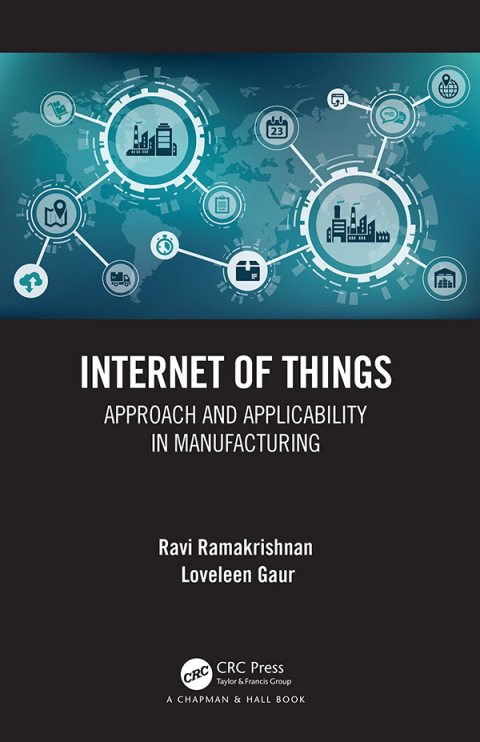Description
Efnisyfirlit
- Cover
- Half Title
- Title Page
- Copyright Page
- Contents
- Preface
- Abbreviations
- Authors
- 1. Demystifying the Industrial IoT Paradigm
- 1.1 Primer
- 1.2 The IoT Adoption—Technology or Strategy Decision
- 1.3 Industrial IoT
- 1.4 IIoT Taxonomies
- 1.5 IoT Challenges in Agile Manufacturing
- 1.6 Drivers for IIoT Adoption
- 1.7 IIoT for Process Management
- 1.8 IIoT Protocols
- 1.9 Product Development and IoT
- 1.10 Industry 4.0, IIoT, and Related Developments
- 1.11 Conclusion
- References
- 2. The Internet of Things Applications
- 2.1 General
- 2.1.1 IoT Reference Model
- 2.1.1.1 Device-to-Device Communications
- 2.1.1.2 Device-to-Cloud Communications
- 2.1.1.3 Device-to-Gateway Communications
- 2.1.1.4 Back-End Data-Sharing Model
- 2.1.2 Current Areas of Industrial IoT adoption
- 2.1.2.1 Improving Energy Management
- 2.1.2.2 Increase Process Manufacturing Efficiency
- 2.1.2.3 Organizing Discreet Manufacturing
- 2.1.2.4 Safety in Mining Operations
- 2.1.2.5 Improving Agro Production
- 2.1.2.6 Environmental Compliance
- 2.1.2.7 Retailing and Consumer Analysis
- 2.2 Emerging Areas of IoT Adoption
- 2.2.1 Robotics-Driven Warehouses
- 2.2.2 Process Safety
- 2.2.3 Deep-Learning-Based Predictive Analytics
- 2.2.4 Machine Learning for Decision-Making
- 2.2.5 Connected Machines Assets
- 2.2.6 Inventory Traceability
- 2.2.7 Defective Product Identification
- 2.3 Worldwide IIoT Adoption Case Studies
- 2.3.1 Current and Future Areas of Domestic IoT Adoption
- 2.3.2 Cashless Transactions
- 2.3.3 Retail Industry
- 2.3.4 Home Automation
- 2.3.5 Energy Management
- 2.3.6 City Management
- 2.3.7 Logistics
- 2.3.8 Healthcare
- 2.3.9 Industrial
- 2.3.10 Environmental Monitoring
- 2.4 Conclusion
- References
- 3. Current Technologies
- 3.1 Introduction
- 3.1.1 Identification
- 3.1.2 Sensing
- 3.1.3 Communication
- 3.1.4 Computation
- 3.1.5 Services
- 3.1.6 Semantics
- 3.2 Cloud Deployment Models
- 3.3 Relevant Technologies
- 3.4 Small-Form Factor Computing
- 3.5 Web Services
- 3.6 Wireless Sensor Networks (WSN)
- 3.7 Virtual Sensors
- 3.8 Fog Computing
- 3.9 Artificial Intelligence (AI)
- 3.10 Virtual Reality
- 3.11 Big Data
- 3.12 Blockchain and Cryptography
- 3.13 Semantic Technologies
- 3.14 Fuzzy Logic
- 3.15 Next Generation Networks (NGN)
- 3.16 Future Internet
- 3.17 Nano-Networks
- 3.18 Single-Point Sensing
- 3.19 Future Advancements
- 3.20 Conclusion
- References
- 4. Business Models
- 4.1 Introduction
- 4.2 Business Model Framework
- 4.3 The IoT and Economics Context
- 4.4 The IoT Business Models
- 4.5 Case Studies
- 4.6 The IoT Business Model Based on IT
- 4.6.1 Freemium
- 4.6.2 Digital Add-On Enhancements
- 4.6.3 Razor and Blade and Digital Lock-In
- 4.6.4 Point of Sales (POS)
- 4.6.5 Direct Selling Business Model or Solution Provider Model using Intelligent Objects Self-Service
- 4.6.6 Pay Per Use Business Model
- 4.6.7 Digitally Charged Products Business Model
- 4.6.8 Data Sale
- 4.7 Challenges and Conclusion
- References
- 5. Smart Manufacturing
- 5.1 Introduction
- 5.2 Manufacturing Concerns
- 5.2.1 Compliances
- 5.2.2 Right Product Mix
- 5.2.3 Skill Gap
- 5.2.4 Shop Floor Productivity
- 5.2.5 Energy Monitoring
- 5.2.6 Operational Efficiency of Machines
- 5.3 Industry 4.0 and Related Models
- 5.4 Smart Manufacturing
- 5.4.1 Smart Design
- 5.4.2 Smart Machines
- 5.4.3 Monitoring
- 5.4.4 Control
- 5.4.5 Dynamic and On-Demand Scheduling
- 5.4.6 Collaboration
- 5.4.7 Digitized Products
- 5.4.8 The IoT-Driven Process
- 5.4.9 The IoT and People
- 5.4.10 Scalable IT Systems
- 5.4.11 Financial Feasibility
- 5.4.12 Autonomous Functioning Driven by Machine Data
- 5.5 Smart Manufacturing: Indian Case Study
- 5.6 Conclusion
- References
- 6. Energy Consumption
- 6.1 Introduction
- 6.2 Energy Management Practices
- 6.3 The IoT for Energy Management
- 6.4 Industrial Case Study
- 6.5 Conclusion
- References
- Bibliography
- 7. Logistics Optimization
- 7.1 Introduction
- 7.2 Challenges in Logistics
- 7.3 Logistics Costs
- 7.4 Autonomous Logistics
- 7.5 The IoT-Enabled Activity-Based Costing
- 7.6 The IoT and Inventory Consolidation
- 7.7 The IoT and Consigned Inventory
- 7.8 Case Study: Industrial Logistics
- 7.9 Conclusion
- References
- 8. Distribution Channel Management
- 8.1 Introduction
- 8.2 The IoT Applications in Retail Distribution
- 8.3 Field Research
- 8.3.1 Consumer White Goods
- 8.3.2 Super Mart Items
- 8.3.3 Food Items
- 8.3.4 Fashion
- 8.3.5 Logistics
- 8.3.6 Energy Management
- 8.3.7 In-Store Technology
- 8.4 The IoT Case Studies in Retail
- 8.5 Costa Coffee
- 8.6 Conclusion
- References
- 9. Green Manufacturing
- 9.1 Introduction
- 9.2 Framework for Green Manufacturing
- 9.3 Case Study
- 9.4 Collaborative IoT for Advanced Manufacturing
- 9.5 Green IoT
- 9.6 Conclusions
- References
- 10. User Perceptions
- 10.1 Introduction
- 10.2 The IoT-UPM (User Perceptions Model)
- 10.3 The IoT Technology Acceptance Model
- 10.4 The IoT Maturity Model
- 10.4.1 Traditional IT Systems
- 10.4.2 People
- 10.4.3 Connected Assets
- 10.4.4 Digital Products
- 10.4.5 Financial Feasibility
- 10.5 Insights Based on a Field Survey
- 10.6 Conclusion
- References
- 11. The Future of the Internet of Things
- 11.1 Introduction
- 11.2 Hybrid Technologies
- 11.3 Futuristic Manufacturing Value Chains
- 11.4 Futuristic Consumer IoT
- 11.5 Emerging Trends
- 11.5.1 Operating Platforms
- 11.5.2 Standards
- 11.5.3 Distributed Stream Computing
- 11.5.4 Operating Systems
- 11.5.5 Hardware
- 11.5.6 Networks
- 11.5.7 Analytics
- 11.5.8 Wider Scope
- 11.5.9 Security
- 11.5.10 Identity Management
- 11.6 Future Development
- 11.7 Conclusion
- References
- 12. Governance, Security, and Privacy
- 12.1 Introduction
- 12.2 Classification
- 12.3 Types of the IoT Attacks
- 12.4 Current Protocols and Challenges
- 12.5 Network Level Security
- 12.6 Authorization and Authentication
- 12.7 Privacy in the IoT
- 12.8 Governance Issues
- 12.9 Conclusion
- References
- Index





